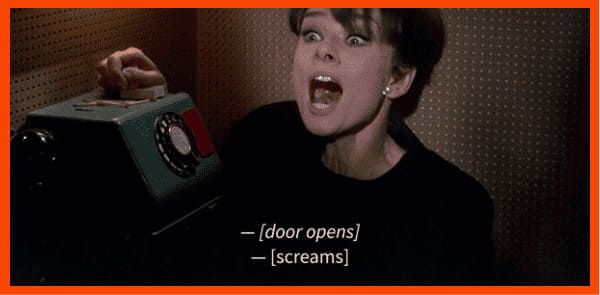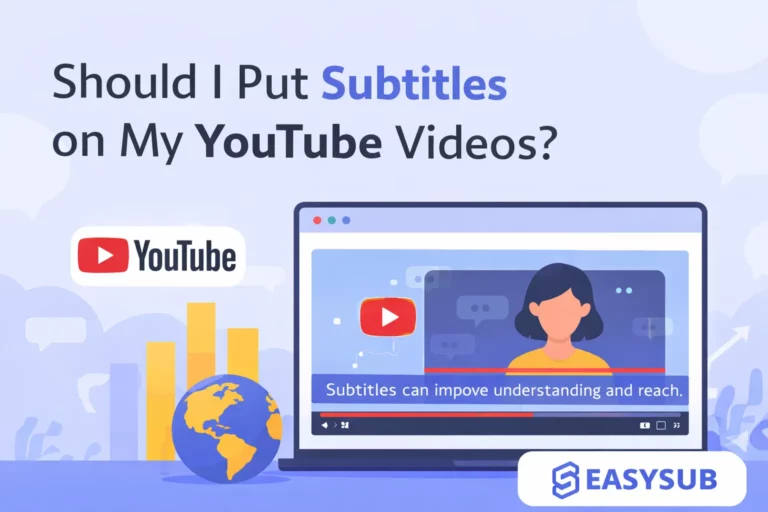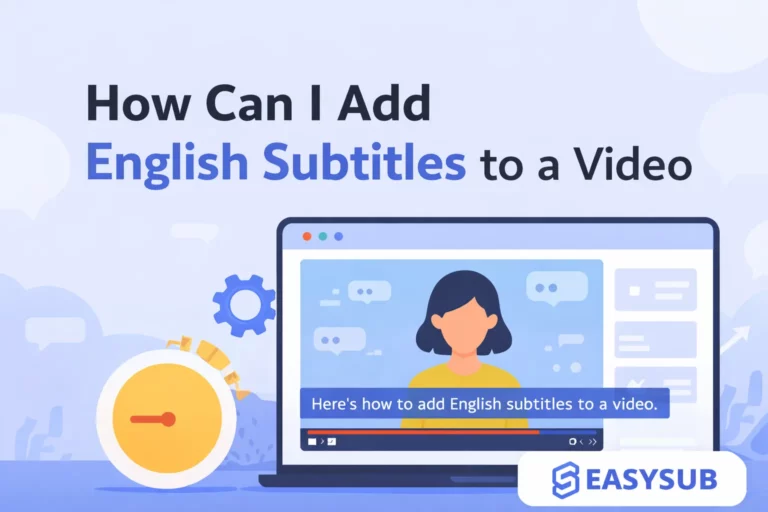ਵੀਡੀਓ ਅਪਲੋਡ ਕਰਨ, ਔਨਲਾਈਨ ਕੋਰਸ ਬਣਾਉਣ, ਜਾਂ ਸੋਸ਼ਲ ਮੀਡੀਆ ਸਮੱਗਰੀ ਚਲਾਉਣ ਦੇ ਦੌਰਾਨ, ਅਸੀਂ ਅਕਸਰ "ਉਪਸਿਰਲੇਖ" ਅਤੇ "ਬੰਦ ਸੁਰਖੀਆਂ" ਵਿਕਲਪਾਂ ਦਾ ਸਾਹਮਣਾ ਕਰਦੇ ਹਾਂ। ਬਹੁਤ ਸਾਰੇ ਲੋਕ ਸੋਚਦੇ ਹਨ ਕਿ ਉਹਨਾਂ ਨੂੰ ਸਿਰਫ਼ ਵੱਖਰੇ ਤੌਰ 'ਤੇ ਕਿਹਾ ਜਾਂਦਾ ਹੈ, ਪਰ ਉਹਨਾਂ ਦੇ ਕਾਰਜ ਘੱਟ ਜਾਂ ਵੱਧ ਇੱਕੋ ਜਿਹੇ ਹਨ। ਦਰਅਸਲ, ਹਾਲਾਂਕਿ, ਵਰਤੋਂ, ਦਰਸ਼ਕਾਂ ਅਤੇ ਕਾਨੂੰਨੀ ਪਾਲਣਾ ਦੀਆਂ ਜ਼ਰੂਰਤਾਂ ਦੇ ਮਾਮਲੇ ਵਿੱਚ ਦੋ ਕਿਸਮਾਂ ਦੇ ਸੁਰਖੀਆਂ ਵਿੱਚ ਮਹੱਤਵਪੂਰਨ ਅੰਤਰ ਹਨ।.
ਗਲੋਬਲ ਸਮੱਗਰੀ ਵੰਡ, ਪਹੁੰਚਯੋਗਤਾ ਪਾਲਣਾ, ਅਤੇ ਬਹੁ-ਭਾਸ਼ਾਈ ਉਪਸਿਰਲੇਖ ਆਉਟਪੁੱਟ ਦੇ ਮਹੱਤਵਪੂਰਨ ਹੋਣ ਦੇ ਨਾਲ, ਅਸਲ ਅੰਤਰਾਂ ਨੂੰ ਸਮਝਣਾ ਅਤੇ ਆਪਣੀਆਂ ਸਮੱਗਰੀ ਦੀਆਂ ਜ਼ਰੂਰਤਾਂ ਲਈ ਸਹੀ ਉਪਸਿਰਲੇਖ ਫਾਰਮੈਟ ਚੁਣਨਾ ਪੇਸ਼ੇਵਰ ਸਿਰਜਣਹਾਰਾਂ ਅਤੇ ਸਮੱਗਰੀ ਟੀਮਾਂ ਲਈ ਇੱਕ ਜ਼ਰੂਰੀ ਹੁਨਰ ਬਣ ਗਿਆ ਹੈ।.
ਇਹ ਲੇਖ ਤੁਹਾਨੂੰ ਉਪਸਿਰਲੇਖਾਂ ਅਤੇ ਬੰਦ ਕੈਪਸ਼ਨਿੰਗ ਦੀਆਂ ਪਰਿਭਾਸ਼ਾਵਾਂ, ਅੰਤਰਾਂ ਅਤੇ ਐਪਲੀਕੇਸ਼ਨ ਦ੍ਰਿਸ਼ਾਂ ਦਾ ਡੂੰਘਾਈ ਨਾਲ ਵਿਸ਼ਲੇਸ਼ਣ ਦੇਵੇਗਾ। ਈਜ਼ੀਸਬ ਪਲੇਟਫਾਰਮ 'ਤੇ ਸਾਡੇ ਵਿਹਾਰਕ ਤਜ਼ਰਬੇ ਦੇ ਨਾਲ, ਇਹ ਲੇਖ ਤੁਹਾਨੂੰ ਘੱਟ ਤੋਂ ਘੱਟ ਸਮੇਂ ਵਿੱਚ ਆਪਣੀ ਸਮੱਗਰੀ ਲਈ ਸਹੀ, ਪੇਸ਼ੇਵਰ ਅਤੇ ਪਲੇਟਫਾਰਮ-ਅਨੁਕੂਲ ਕੈਪਸ਼ਨਿੰਗ ਹੱਲ ਕਿਵੇਂ ਚੁਣਨਾ ਹੈ ਇਸ ਵਿੱਚ ਮੁਹਾਰਤ ਹਾਸਲ ਕਰਨ ਵਿੱਚ ਮਦਦ ਕਰੇਗਾ।.
ਵਿਸ਼ਾ - ਸੂਚੀ
ਉਪਸਿਰਲੇਖ ਕੀ ਹੈ?
ਵੀਡੀਓ ਵੰਡ ਦੇ ਵਧਦੇ ਵਿਸ਼ਵੀਕਰਨ ਦੇ ਨਾਲ, ਉਪਸਿਰਲੇਖ ਦਰਸ਼ਕਾਂ ਨੂੰ ਭਾਸ਼ਾ ਦੀਆਂ ਰੁਕਾਵਟਾਂ ਨੂੰ ਪਾਰ ਕਰਨ ਅਤੇ ਉਨ੍ਹਾਂ ਦੇ ਦੇਖਣ ਦੇ ਅਨੁਭਵ ਨੂੰ ਵਧਾਉਣ ਵਿੱਚ ਮਦਦ ਕਰਨ ਲਈ ਇੱਕ ਮਹੱਤਵਪੂਰਨ ਸਾਧਨ ਬਣ ਗਏ ਹਨ। ਤਾਂ ਉਪਸਿਰਲੇਖ ਅਸਲ ਵਿੱਚ ਕੀ ਹੈ? ਅਤੇ ਇਸਦਾ ਸਪਸ਼ਟ ਤੌਰ 'ਤੇ ਪਰਿਭਾਸ਼ਿਤ ਕਾਰਜ ਅਤੇ ਦਾਇਰਾ ਕੀ ਹੈ?
ਉਪਸਿਰਲੇਖਾਂ ਦੀ ਪਰਿਭਾਸ਼ਾ
ਉਪਸਿਰਲੇਖ ਸਕ੍ਰੀਨ 'ਤੇ ਟੈਕਸਟ ਦੇ ਰੂਪ ਵਿੱਚ ਪੇਸ਼ ਕੀਤੇ ਗਏ ਵੀਡੀਓ ਵਿੱਚ ਸਪੀਕਰ ਦੀ ਮੌਖਿਕ ਸਮੱਗਰੀ ਹੁੰਦੇ ਹਨ। ਇਹ ਮੁੱਖ ਤੌਰ 'ਤੇ ਦਰਸ਼ਕਾਂ ਨੂੰ ਵੀਡੀਓ ਵਿੱਚ ਬੋਲੀ ਗਈ ਸਮੱਗਰੀ ਨੂੰ ਸਮਝਣ ਵਿੱਚ ਮਦਦ ਕਰਨ ਲਈ ਵਰਤਿਆ ਜਾਂਦਾ ਹੈ। ਉਪਸਿਰਲੇਖਾਂ ਵਿੱਚ ਆਮ ਤੌਰ 'ਤੇ ਸਹਾਇਕ ਜਾਣਕਾਰੀ ਨਹੀਂ ਹੁੰਦੀ ਜਿਵੇਂ ਕਿ ਪਿਛੋਕੜ ਵਾਲੇ ਧੁਨੀ ਪ੍ਰਭਾਵ ਅਤੇ ਗੈਰ-ਮੌਖਿਕ ਸੰਕੇਤ। ਇਸਦੇ ਨਿਸ਼ਾਨਾ ਉਪਭੋਗਤਾ ਮੁੱਖ ਤੌਰ 'ਤੇ ਹਨ:
- ਉਹ ਉਪਭੋਗਤਾ ਜੋ ਭਾਸ਼ਾ ਸਮਝਦੇ ਹਨ ਪਰ ਵਿਜ਼ੂਅਲ ਏਡਜ਼ ਦੀ ਲੋੜ ਹੁੰਦੀ ਹੈ (ਜਿਵੇਂ ਕਿ, ਸ਼ਾਂਤ ਜਾਂ ਰੌਲੇ-ਰੱਪੇ ਵਾਲੇ ਵਾਤਾਵਰਣ ਵਿੱਚ ਦੇਖਣਾ)
- ਗੈਰ-ਮੂਲ ਭਾਸ਼ਾ ਬੋਲਣ ਵਾਲੇ (ਜਿਵੇਂ ਕਿ, ਅੰਗਰੇਜ਼ੀ ਭਾਸ਼ਾ ਦੀ ਫਿਲਮ ਦੇਖ ਰਹੇ ਚੀਨੀ ਭਾਸ਼ਾ ਬੋਲਣ ਵਾਲੇ ਦਰਸ਼ਕ)
ਉਦਾਹਰਣ: ਜੇਕਰ ਤੁਸੀਂ Netflix 'ਤੇ ਕੋਰੀਆਈ ਜਾਂ ਜਾਪਾਨੀ ਡਰਾਮਾ ਦੇਖਦੇ ਸਮੇਂ "ਅੰਗਰੇਜ਼ੀ ਉਪਸਿਰਲੇਖ" ਚੁਣਦੇ ਹੋ, ਤਾਂ ਤੁਹਾਨੂੰ ਉਪਸਿਰਲੇਖ ਦਿਖਾਈ ਦੇਣਗੇ।.
ਉਪਸਿਰਲੇਖਾਂ ਦੇ ਫਾਰਮੈਟ ਅਤੇ ਤਕਨੀਕੀ ਅਹਿਸਾਸ
ਆਮ ਉਪਸਿਰਲੇਖ ਫਾਰਮੈਟਾਂ ਵਿੱਚ ਸ਼ਾਮਲ ਹਨ:
- .ਐਸਆਰਟੀ: ਸਭ ਤੋਂ ਮੁੱਖ ਧਾਰਾ ਫਾਰਮੈਟ, ਉੱਚ ਅਨੁਕੂਲਤਾ, ਸੰਪਾਦਿਤ ਕਰਨ ਵਿੱਚ ਆਸਾਨ
- .ਵੀਟੀਟੀ: HTML5 ਵੀਡੀਓ ਪਲੇਅਰ ਵਿੱਚ ਆਮ ਤੌਰ 'ਤੇ ਵਰਤਿਆ ਜਾਣ ਵਾਲਾ ਫਾਰਮੈਟ।.
- .ਗਧਾ: ਉੱਨਤ ਸ਼ੈਲੀਆਂ ਦਾ ਸਮਰਥਨ ਕਰਦਾ ਹੈ, ਜੋ ਪੋਸਟ-ਪ੍ਰੋਡਕਸ਼ਨ ਉਪਸਿਰਲੇਖ ਉਤਪਾਦਨ ਲਈ ਢੁਕਵਾਂ ਹੈ।.
ਪੇਸ਼ੇਵਰ ਉਪਸਿਰਲੇਖ ਟੂਲ (ਜਿਵੇਂ ਕਿ ਈਜ਼ੀਸਬ) ਆਮ ਤੌਰ 'ਤੇ AI ਸਪੀਚ ਰਿਕੋਗਨੀਸ਼ਨ (ASR) + ਨੈਚੁਰਲ ਲੈਂਗੂਏਜ ਪ੍ਰੋਸੈਸਿੰਗ (NLP) ਰਾਹੀਂ ਆਡੀਓ ਨੂੰ ਆਟੋਮੈਟਿਕਲੀ ਟੈਕਸਟ ਵਿੱਚ ਬਦਲਦਾ ਹੈ। ਅਤੇ ਟਾਈਮਕੋਡ ਅਲਾਈਨਮੈਂਟ ਰਾਹੀਂ ਸਟੈਂਡਰਡ ਸਬਟਾਈਟਲ ਫਾਈਲਾਂ ਤਿਆਰ ਕਰਦਾ ਹੈ, ਮਲਟੀ-ਲੈਂਗਵੇਜ ਆਉਟਪੁੱਟ ਅਤੇ ਫਾਰਮੈਟ ਐਕਸਪੋਰਟ ਦਾ ਸਮਰਥਨ ਕਰਦਾ ਹੈ।.

ਉਪਸਿਰਲੇਖ ਇੰਨੇ ਮਹੱਤਵਪੂਰਨ ਕਿਉਂ ਹਨ? ਕੈਪਸ਼ਨ ਸੁਣਨ ਸ਼ਕਤੀ ਤੋਂ ਕਮਜ਼ੋਰ ਲੋਕਾਂ ਨੂੰ ਵੀਡੀਓ ਕੀ ਦੱਸ ਰਿਹਾ ਹੈ, ਇਹ ਬਿਹਤਰ ਢੰਗ ਨਾਲ ਸਮਝਣ ਵਿੱਚ ਮਦਦ ਕਰਦਾ ਹੈ। ਭਾਵੇਂ ਉਹ ਸੁਣਨ ਸ਼ਕਤੀ ਤੋਂ ਕਮਜ਼ੋਰ ਨਹੀਂ ਹਨ, ਦਰਸ਼ਕਾਂ ਨੂੰ ਕਈ ਕਾਰਨਾਂ ਕਰਕੇ (ਆਉਣਾ-ਜਾਣਾ, ਮੀਟਿੰਗਾਂ, ਸ਼ਾਂਤ ਵਾਤਾਵਰਣ) ਉਪਸਿਰਲੇਖ ਪੜ੍ਹਨ ਦੀ ਲੋੜ ਹੋ ਸਕਦੀ ਹੈ।.
ਇਸ ਤੋਂ ਇਲਾਵਾ, ਸਵੈ-ਪ੍ਰਕਾਸ਼ਕਾਂ ਲਈ, ਉਪਸਿਰਲੇਖ ਵੀਡੀਓ ਦੇ SEO ਨੂੰ ਵਧਾ ਸਕਦੇ ਹਨ। ਉਪਸਿਰਲੇਖ ਵਾਲੀ ਟੈਕਸਟ ਸਮੱਗਰੀ ਨੂੰ ਖੋਜ ਇੰਜਣਾਂ ਦੁਆਰਾ ਇੰਡੈਕਸ ਕੀਤਾ ਜਾ ਸਕਦਾ ਹੈ, ਜਿਸ ਨਾਲ ਵੀਡੀਓ ਦੇ ਲੱਭਣ ਦੀ ਸੰਭਾਵਨਾ ਵੱਧ ਜਾਂਦੀ ਹੈ।.
ਬੰਦ ਕੈਪਸ਼ਨਿੰਗ ਕੀ ਹੈ?
ਹਾਲਾਂਕਿ ਅਸੀਂ ਅਕਸਰ "ਕੈਪਸ਼ਨਿੰਗ" ਦਾ ਹਵਾਲਾ ਦਿੰਦੇ ਹਾਂ,“ ਬੰਦ ਸੁਰਖੀਆਂ (CC) ਰਵਾਇਤੀ ਉਪਸਿਰਲੇਖਾਂ ਵਰਗਾ ਨਹੀਂ ਹੈ, ਜੋ ਕਿ ਟੈਲੀਵਿਜ਼ਨ ਪ੍ਰਸਾਰਣ ਉਦਯੋਗ ਵਿੱਚ ਸੁਣਨ ਸ਼ਕਤੀ ਤੋਂ ਕਮਜ਼ੋਰ ਲੋਕਾਂ ਦੀਆਂ ਜਾਣਕਾਰੀ ਪਹੁੰਚ ਦੀਆਂ ਜ਼ਰੂਰਤਾਂ ਨੂੰ ਪੂਰਾ ਕਰਨ ਲਈ ਉਤਪੰਨ ਹੋਇਆ ਸੀ। ਬੰਦ ਕੈਪਸ਼ਨਿੰਗ ਟੈਲੀਵਿਜ਼ਨ ਪ੍ਰਸਾਰਣ ਉਦਯੋਗ ਵਿੱਚ ਸੁਣਨ ਸ਼ਕਤੀ ਤੋਂ ਕਮਜ਼ੋਰ ਲੋਕਾਂ ਦੀ ਜਾਣਕਾਰੀ ਤੱਕ ਪਹੁੰਚ ਦੀ ਜ਼ਰੂਰਤ ਦੇ ਜਵਾਬ ਵਜੋਂ ਉਤਪੰਨ ਹੋਈ ਸੀ। ਇਹ ਸਿਰਫ਼ "ਗੱਲਬਾਤ ਦਾ ਟੈਕਸਟ ਸੰਸਕਰਣ" ਤੋਂ ਵੱਧ ਹੈ; ਇਹ ਇੱਕ ਕੈਪਸ਼ਨਿੰਗ ਮਿਆਰ ਹੈ ਜੋ ਪਹੁੰਚਯੋਗਤਾ 'ਤੇ ਜ਼ੋਰ ਦਿੰਦਾ ਹੈ।.
ਬਹੁਤ ਸਾਰੇ ਦੇਸ਼ਾਂ (ਖਾਸ ਕਰਕੇ ਸੰਯੁਕਤ ਰਾਜ ਅਮਰੀਕਾ) ਵਿੱਚ, CC ਕਾਨੂੰਨੀ ਤੌਰ 'ਤੇ ਵੀ ਲਾਜ਼ਮੀ ਹੈ। ਕਿਸੇ ਵੀ ਸਮੱਗਰੀ ਸਿਰਜਣਹਾਰ, ਵਿਦਿਅਕ ਸੰਸਥਾ, ਜਾਂ ਕਾਰੋਬਾਰ ਲਈ ਕਲੋਜ਼ਡ ਕੈਪਸ਼ਨਿੰਗ ਕੀ ਹੈ, ਇਹ ਕਿਵੇਂ ਵੱਖਰਾ ਹੈ, ਅਤੇ ਉਹਨਾਂ ਦ੍ਰਿਸ਼ਾਂ ਨੂੰ ਸਮਝਣਾ ਜ਼ਰੂਰੀ ਹੈ ਜਿਨ੍ਹਾਂ ਵਿੱਚ ਇਸਨੂੰ ਵਰਤਿਆ ਜਾ ਸਕਦਾ ਹੈ।.
ਬੰਦ ਸੁਰਖੀਆਂ ਦੀ ਪਰਿਭਾਸ਼ਾ
ਕਲੋਜ਼ਡ ਕੈਪਸ਼ਨਿੰਗ (CC) ਵੀਡੀਓ-ਸਹਾਇਤਾ ਪ੍ਰਾਪਤ ਟੈਕਸਟ ਦੀ ਇੱਕ ਪ੍ਰਣਾਲੀ ਨੂੰ ਦਰਸਾਉਂਦੀ ਹੈ ਜੋ ਸੁਣਨ ਦੀ ਕਮਜ਼ੋਰੀ ਵਾਲੇ ਲੋਕਾਂ ਲਈ ਤਿਆਰ ਕੀਤੀ ਗਈ ਹੈ। ਨਿਯਮਤ ਕੈਪਸ਼ਨਿੰਗ ਦੇ ਉਲਟ, CC ਵਿੱਚ ਨਾ ਸਿਰਫ਼ ਵੀਡੀਓ ਵਿੱਚ ਸੰਵਾਦ ਸ਼ਾਮਲ ਹੁੰਦਾ ਹੈ, ਸਗੋਂ ਕੋਈ ਵੀ ਗੈਰ-ਮੌਖਿਕ ਜਾਣਕਾਰੀ ਵੀ ਸ਼ਾਮਲ ਹੁੰਦੀ ਹੈ ਜੋ ਸਮਝ ਵਿੱਚ ਵਿਘਨ ਪਾ ਸਕਦੀ ਹੈ। ਉਦਾਹਰਣ ਲਈ:
- ਬੈਕਗ੍ਰਾਊਂਡ ਧੁਨੀ ਪ੍ਰਭਾਵ (ਜਿਵੇਂ ਕਿ [ਧਮਾਕਾ], [ਸੈਲ ਫ਼ੋਨ ਵਾਈਬ੍ਰੇਸ਼ਨ])
- ਸੁਰ ਸੰਕੇਤ (ਜਿਵੇਂ ਕਿ [ਵਿਅੰਗ ਨਾਲ ਹੱਸਣਾ], [ਫੁਸਫੁਸਾਉਣਾ])
- ਸੰਗੀਤ ਸੰਕੇਤ (ਜਿਵੇਂ ਕਿ [ਨਰਮ ਸੰਗੀਤ ਵਜਾਉਣਾ])
ਇਸਦਾ ਮੁੱਖ ਉਦੇਸ਼ ਭਾਸ਼ਾ ਦਾ ਅਨੁਵਾਦ ਕਰਨਾ ਨਹੀਂ ਹੈ, ਸਗੋਂ ਵੀਡੀਓ ਵਿੱਚ ਸਾਰੀ ਸੁਣਨ ਸੰਬੰਧੀ ਜਾਣਕਾਰੀ ਨੂੰ ਪੂਰੀ ਤਰ੍ਹਾਂ ਪ੍ਰਦਾਨ ਕਰਨਾ ਹੈ। ਇਹ ਯਕੀਨੀ ਬਣਾਉਣਾ ਕਿ ਸੁਣਨ ਤੋਂ ਕਮਜ਼ੋਰ ਵਿਅਕਤੀ ਬਿਨਾਂ ਆਵਾਜ਼ ਦੇ ਪੂਰੀ ਵੀਡੀਓ "ਸੁਣ" ਸਕਣ।.
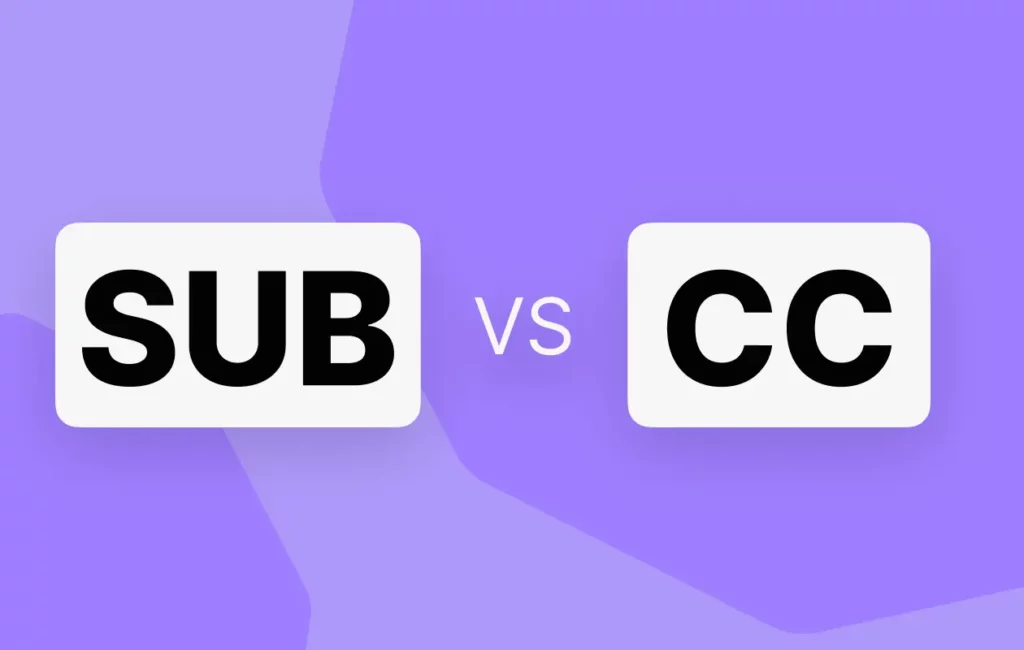
ਈਜ਼ੀਸਬ ਕਲੋਜ਼ਡ ਕੈਪਸ਼ਨਿੰਗ ਜਨਰੇਸ਼ਨ ਦਾ ਸਮਰਥਨ ਕਿਵੇਂ ਕਰਦਾ ਹੈ?
ਇੱਕ ਪੇਸ਼ੇਵਰ ਬੰਦ ਸੁਰਖੀਆਂ ਵਜੋਂ ਏਆਈ ਟੂਲ, Easysub ਨਾ ਸਿਰਫ਼ ਰਵਾਇਤੀ ਕੈਪਸ਼ਨਿੰਗ ਆਉਟਪੁੱਟ ਦਾ ਸਮਰਥਨ ਕਰਦਾ ਹੈ, ਸਗੋਂ CC ਜ਼ਰੂਰਤਾਂ ਦੇ ਨਾਲ ਵੀ ਪੂਰੀ ਤਰ੍ਹਾਂ ਅਨੁਕੂਲ ਹੈ:
- ਆਡੀਓ ਵਿੱਚ ਸੰਵਾਦ + ਧੁਨੀ ਪ੍ਰਭਾਵਾਂ ਨੂੰ ਆਪਣੇ ਆਪ ਪਛਾਣੋ।.
- ਵੌਇਸ ਵਿਸ਼ੇਸ਼ਤਾਵਾਂ ਨੂੰ ਐਨੋਟੇਟ ਕਰਨ ਲਈ ਸਮਰਥਨ (ਜਿਵੇਂ ਕਿ "ਗੁੱਸੇ ਨਾਲ ਕਿਹਾ", "ਫੁਸਫੁਸਾਇਆ")।.
- ਧੁਨੀ ਸੰਕੇਤਾਂ ਸਮੇਤ, ਮਿਆਰੀ .srt, .vtt ਫਾਰਮੈਟਾਂ ਵਿੱਚ ਨਿਰਯਾਤ ਕਰੋ।.
- ਗਲੋਬਲ ਪਲੇਟਫਾਰਮ ਪਹੁੰਚਯੋਗਤਾ ਜ਼ਰੂਰਤਾਂ ਨੂੰ ਪੂਰਾ ਕਰਨ ਲਈ ਅੰਗਰੇਜ਼ੀ ਅਤੇ ਚੀਨੀ ਵਿੱਚ ਬਹੁ-ਭਾਸ਼ਾਈ ਸੀਸੀ ਜਨਰੇਸ਼ਨ ਦਾ ਸਮਰਥਨ ਕਰਦਾ ਹੈ।.
Easysub ਸਿਰਜਣਹਾਰਾਂ ਅਤੇ ਸੰਗਠਨਾਂ ਲਈ ਇੱਕ ਨਿਯੰਤਰਿਤ, ਅਨੁਕੂਲ, ਅਤੇ ਵਰਤੋਂ ਵਿੱਚ ਆਸਾਨ ਬੰਦ ਕੈਪਸ਼ਨਿੰਗ ਹੱਲ ਪ੍ਰਦਾਨ ਕਰਦਾ ਹੈ ਜਿਨ੍ਹਾਂ ਨੂੰ ਰੈਗੂਲੇਟਰੀ ਜ਼ਰੂਰਤਾਂ ਦੀ ਪਾਲਣਾ ਕਰਨ, ਸਮੱਗਰੀ ਸ਼ਾਮਲ ਕਰਨ ਨੂੰ ਵਧਾਉਣ ਅਤੇ ਵਿਸ਼ੇਸ਼ ਆਬਾਦੀ ਦੀ ਸੇਵਾ ਕਰਨ ਦੀ ਲੋੜ ਹੁੰਦੀ ਹੈ।.
ਬੰਦ ਕੈਪਸ਼ਨਿੰਗ ਬਨਾਮ ਉਪਸਿਰਲੇਖ: ਅੰਤਰ
ਹਾਲਾਂਕਿ ਬਹੁਤ ਸਾਰੇ ਲੋਕ 'ਕੈਪਸ਼ਨਿੰਗ' ਅਤੇ 'ਬੰਦ ਕੈਪਸ਼ਨਿੰਗ' ਨੂੰ ਇੱਕੋ ਸੰਕਲਪ ਮੰਨਦੇ ਹਨ। ਹਾਲਾਂਕਿ, ਇਹ ਅਸਲ ਵਿੱਚ ਇੱਕ ਦੂਜੇ ਤੋਂ ਬੁਨਿਆਦੀ ਤੌਰ 'ਤੇ ਵੱਖਰੇ ਹਨ, ਤਕਨੀਕੀ ਪਰਿਭਾਸ਼ਾਵਾਂ, ਲਾਗੂ ਆਬਾਦੀ ਤੋਂ ਲੈ ਕੇ ਪਾਲਣਾ ਜ਼ਰੂਰਤਾਂ ਤੱਕ।.
| ਤੁਲਨਾ ਆਈਟਮ | ਉਪਸਿਰਲੇਖ | ਬੰਦ ਸੁਰਖੀਆਂ (CC) |
|---|---|---|
| ਫੰਕਸ਼ਨ | ਗੈਰ-ਮੂਲ ਦਰਸ਼ਕਾਂ ਲਈ ਭਾਸ਼ਣ ਦਾ ਅਨੁਵਾਦ ਕਰਦਾ ਹੈ | ਸੁਣਨ-ਕਮਜ਼ੋਰ ਉਪਭੋਗਤਾਵਾਂ ਲਈ ਸਾਰੀ ਆਡੀਓ ਸਮੱਗਰੀ ਨੂੰ ਟ੍ਰਾਂਸਕ੍ਰਾਈਬ ਕਰਦਾ ਹੈ। |
| ਸਮੱਗਰੀ ਦਾ ਘੇਰਾ | ਸਿਰਫ਼ ਬੋਲੇ ਗਏ ਸੰਵਾਦ ਦਿਖਾਉਂਦਾ ਹੈ (ਮੂਲ ਜਾਂ ਅਨੁਵਾਦਿਤ) | ਸੰਵਾਦ + ਧੁਨੀ ਪ੍ਰਭਾਵ + ਪਿਛੋਕੜ ਸ਼ੋਰ + ਸੁਰ ਵਰਣਨ ਸ਼ਾਮਲ ਹਨ |
| ਟਾਰਗੇਟ ਯੂਜ਼ਰਸ | ਵਿਸ਼ਵਵਿਆਪੀ ਦਰਸ਼ਕ, ਗੈਰ-ਮੂਲ ਬੁਲਾਰੇ | ਬੋਲ਼ੇ ਜਾਂ ਘੱਟ ਸੁਣਨ ਵਾਲੇ ਦਰਸ਼ਕ |
| ਟੌਗਲ ਚਾਲੂ/ਬੰਦ | ਆਮ ਤੌਰ 'ਤੇ ਸਥਿਰ ਜਾਂ ਹਾਰਡ-ਕੋਡਿਡ (ਖਾਸ ਕਰਕੇ ਓਪਨ ਕੈਪਸ਼ਨ) | ਚਾਲੂ/ਬੰਦ ਕੀਤਾ ਜਾ ਸਕਦਾ ਹੈ (ਬੰਦ ਸੁਰਖੀਆਂ) |
| ਕਾਨੂੰਨੀ ਲੋੜ | ਵਿਕਲਪਿਕ, ਪਲੇਟਫਾਰਮ/ਉਪਭੋਗਤਾ 'ਤੇ ਨਿਰਭਰ ਕਰਦਾ ਹੈ | ਅਕਸਰ ਕਾਨੂੰਨੀ ਤੌਰ 'ਤੇ ਲੋੜੀਂਦਾ (FCC, ADA, ਵਿਦਿਅਕ/ਸਰਕਾਰੀ ਸਮੱਗਰੀ) |
| ਫਾਰਮੈਟ ਸਹਾਇਤਾ | ਆਮ: .srt, .vtt, .ਖੋਤਾ | ਇਹ ਵੀ ਸਮਰਥਨ ਕਰਦਾ ਹੈ .srt, .vtt, ਪਰ ਗੈਰ-ਭਾਸ਼ਣ ਤੱਤ ਸ਼ਾਮਲ ਹਨ |
| ਸਭ ਤੋਂ ਵਧੀਆ ਵਰਤੋਂ ਵਾਲਾ ਮਾਮਲਾ | ਬਹੁ-ਭਾਸ਼ਾਈ ਵੀਡੀਓ ਪ੍ਰਕਾਸ਼ਨ ਲਈ ਵਧੀਆ | ਪਾਲਣਾ, ਪਹੁੰਚਯੋਗਤਾ, ਸਿੱਖਿਆ, ਕਾਰਪੋਰੇਟ ਸਮੱਗਰੀ ਲਈ ਆਦਰਸ਼ |
ਸਿਫਾਰਸ਼:
- ਜੇਕਰ ਤੁਹਾਡਾ ਟੀਚਾ ਹੈ ਕਿ “"ਵਿਸ਼ਵਵਿਆਪੀ ਸੰਚਾਰ ਨੂੰ ਵਧਾਓ"”, ਤੁਹਾਨੂੰ ਕਿਸੇ ਵੀ ਹੋਰ ਚੀਜ਼ ਨਾਲੋਂ ਵੱਧ ਉਪਸਿਰਲੇਖਾਂ ਦੀ ਲੋੜ ਹੈ।.
- ਜੇਕਰ ਤੁਹਾਡਾ ਟੀਚਾ ਹੈ ਕਿ “"ਅਪਾਹਜ ਲੋਕਾਂ ਲਈ ਪਹੁੰਚਯੋਗਤਾ ਯਕੀਨੀ ਬਣਾਓ / ਰੈਗੂਲੇਟਰੀ ਪਾਲਣਾ ਨੂੰ ਪੂਰਾ ਕਰੋ", ਤੁਹਾਨੂੰ ਬੰਦ ਸੁਰਖੀਆਂ ਦੀ ਲੋੜ ਹੈ।.
- ਆਦਰਸ਼ਕ ਤੌਰ 'ਤੇ, ਤੁਸੀਂ ਦੋਵੇਂ ਚਾਹੁੰਦੇ ਹੋ। ਖਾਸ ਕਰਕੇ ਸਿੱਖਿਆ, ਉੱਦਮ, ਅਤੇ ਵਿਦੇਸ਼ੀ ਸਮੱਗਰੀ ਖੇਤਰਾਂ ਵਿੱਚ, ਬਹੁ-ਭਾਸ਼ਾਈ ਕੈਪਸ਼ਨਿੰਗ + CC ਸੰਸਕਰਣ ਦੋਵੇਂ ਹੋਣ ਦੀ ਸਿਫਾਰਸ਼ ਕੀਤੀ ਜਾਂਦੀ ਹੈ।.
ਕਿਹੜਾ ਸਬਟਾਈਟਲ ਫਾਰਮੈਟ ਕਦੋਂ ਚੁਣਨਾ ਹੈ?
ਉਪਸਿਰਲੇਖਾਂ ਅਤੇ ਬੰਦ ਕੈਪਸ਼ਨਿੰਗ ਵਿੱਚ ਅੰਤਰ ਨੂੰ ਸਮਝਣ ਤੋਂ ਬਾਅਦ, ਬਹੁਤ ਸਾਰੇ ਉਪਭੋਗਤਾ ਪੁੱਛਦੇ ਹਨ: ਤਾਂ ਮੈਨੂੰ ਕਿਹੜਾ ਵਰਤਣਾ ਚਾਹੀਦਾ ਹੈ? ਦਰਅਸਲ, ਕਿਹੜਾ ਉਪਸਿਰਲੇਖ ਫਾਰਮੈਟ ਚੁਣਨਾ ਹੈ ਇਹ ਨਾ ਸਿਰਫ਼ ਦਰਸ਼ਕ 'ਤੇ ਨਿਰਭਰ ਕਰਦਾ ਹੈ, ਸਗੋਂ ਤੁਹਾਡੀ ਸਮੱਗਰੀ ਦੀ ਕਿਸਮ, ਵੰਡ ਪਲੇਟਫਾਰਮ, ਕਾਨੂੰਨਾਂ ਅਤੇ ਨਿਯਮਾਂ, ਭਾਸ਼ਾ ਦੀਆਂ ਜ਼ਰੂਰਤਾਂ ਅਤੇ ਹੋਰ ਕਾਰਕਾਂ ਨਾਲ ਵੀ ਨੇੜਿਓਂ ਸਬੰਧਤ ਹੈ।.
1️⃣ ਯੂਟਿਊਬ ਸਿਰਜਣਹਾਰ / ਸਵੈ-ਪ੍ਰਕਾਸ਼ਿਤ ਵੀਡੀਓ
- ਟੀਚਾ: ਦੇਖਣ ਦੇ ਅਨੁਭਵ ਨੂੰ ਬਿਹਤਰ ਬਣਾਓ, ਬਹੁ-ਭਾਸ਼ਾਈ ਵੰਡ ਦਾ ਸਮਰਥਨ ਕਰੋ
- ਸਿਫਾਰਸ਼: ਉਪਸਿਰਲੇਖਾਂ ਨੂੰ ਤਰਜੀਹ ਦਿਓ।.
- SEO ਅਤੇ ਪਲੇਟਫਾਰਮ ਰੈਫਰਲ ਨੂੰ ਬਿਹਤਰ ਬਣਾਉਣ ਲਈ CC ਸੰਸਕਰਣ ਦੇ ਨਾਲ ਆ ਸਕਦਾ ਹੈ
2️⃣ ਕਾਰਪੋਰੇਟ ਵੀਡੀਓ / ਸਿਖਲਾਈ ਰਿਕਾਰਡਿੰਗ / ਕਰਮਚਾਰੀ ਆਨਬੋਰਡਿੰਗ ਸਮੱਗਰੀ
- ਟੀਚਾ: ਪਾਲਣਾ + ਅੰਦਰੂਨੀ ਸਰਹੱਦ ਪਾਰ ਸਹਿਯੋਗ
- ਸਿਫਾਰਸ਼: ਅੰਗਰੇਜ਼ੀ ਉਪਸਿਰਲੇਖਾਂ ਦੇ ਨਾਲ ਬੰਦ ਕੈਪਸ਼ਨਿੰਗ (ਆਡੀਓ ਸੰਕੇਤਾਂ ਦੇ ਨਾਲ) ਪ੍ਰਦਾਨ ਕਰੋ।.
3️⃣ ਔਨਲਾਈਨ ਕੋਰਸ / ਵਿਦਿਅਕ ਪਲੇਟਫਾਰਮ (MOOCs)
- ਟੀਚਾ: ਵੱਖ-ਵੱਖ ਭਾਸ਼ਾਈ ਪਿਛੋਕੜਾਂ ਦੇ ਅਨੁਕੂਲਤਾ, ਅਪਾਹਜ ਲੋਕਾਂ ਲਈ ਸਿੱਖਣ ਦੇ ਅਧਿਕਾਰ ਦੀ ਗਰੰਟੀ।.
- ਸਿਫਾਰਸ਼: ਇੱਕੋ ਸਮੇਂ ਉਪਸਿਰਲੇਖ + ਬੰਦ ਸੁਰਖੀਆਂ।.
4️⃣ ਫਿਲਮ ਅਤੇ ਟੀਵੀ ਸਮੱਗਰੀ / ਅੰਤਰਰਾਸ਼ਟਰੀ ਫਿਲਮ ਫੈਸਟੀਵਲ / OTT ਵੀਡੀਓ ਪਲੇਟਫਾਰਮ
- ਟੀਚਾ: ਕਲਾਤਮਕ ਵੰਡ + ਅਨੁਕੂਲ ਵੰਡ
- ਸਿਫਾਰਸ਼: ਬਹੁ-ਭਾਸ਼ਾਈ ਉਪਸਿਰਲੇਖ ਪ੍ਰਦਾਨ ਕਰਨੇ ਚਾਹੀਦੇ ਹਨ ਅਤੇ ਜੇ ਜ਼ਰੂਰੀ ਹੋਵੇ ਤਾਂ ਕਾਨੂੰਨੀ ਤੌਰ 'ਤੇ CC ਲਾਗੂ ਕਰਨਾ ਚਾਹੀਦਾ ਹੈ (ਜਿਵੇਂ ਕਿ ਉੱਤਰੀ ਅਮਰੀਕੀ ਟੀਵੀ ਨੈੱਟਵਰਕ)
5️⃣ ਛੋਟੇ-ਛੋਟੇ ਵੀਡੀਓ ਪਲੇਟਫਾਰਮ (TikTok / Instagram)
- ਟੀਚਾ: ਧਿਆਨ ਖਿੱਚਣ ਵਾਲਾ + ਵਧੀ ਹੋਈ ਪੂਰਤੀ ਦਰ
- ਸਿਫਾਰਸ਼: ਦ੍ਰਿਸ਼ਟੀਗਤ ਤੌਰ 'ਤੇ ਆਕਰਸ਼ਕ ਓਪਨ ਕੈਪਸ਼ਨ ਦੀ ਵਰਤੋਂ ਕਰੋ, ਜੋ ਕਿ ਉਪਸਿਰਲੇਖਾਂ ਜਾਂ CC ਰੂਪਾਂਤਰਨਾਂ ਤੋਂ ਤਿਆਰ ਕੀਤੇ ਜਾ ਸਕਦੇ ਹਨ।
ਈਜ਼ੀਸਬ ਚੋਣ ਪ੍ਰਕਿਰਿਆ ਨੂੰ ਕਿਵੇਂ ਸਰਲ ਬਣਾਉਂਦਾ ਹੈ?
ਅਸਲ ਉਤਪਾਦਨ ਵਿੱਚ, ਤੁਹਾਨੂੰ ਫਾਰਮੈਟਿੰਗ, ਔਜ਼ਾਰਾਂ, ਭਾਸ਼ਾ ਅਨੁਕੂਲਤਾ, ਆਦਿ ਦੀ ਗੁੰਝਲਤਾ ਦਾ ਵਿਅਕਤੀਗਤ ਤੌਰ 'ਤੇ ਨਿਰਣਾ ਕਰਨ ਦੀ ਜ਼ਰੂਰਤ ਨਹੀਂ ਹੈ।. Easysub ਨਾਲ, ਤੁਸੀਂ ਕਰ ਸਕਦੇ ਹੋ:
- ਇੱਕ ਕਲਿੱਕ ਨਾਲ ਵੀਡੀਓ ਅਪਲੋਡ ਕਰੋ, ਅਤੇ ਸਿਸਟਮ ਆਪਣੇ ਆਪ ਹੀ ਅਸਲੀ ਉਪਸਿਰਲੇਖ ਤਿਆਰ ਕਰਦਾ ਹੈ (CC ਅਤੇ ਅਨੁਵਾਦਿਤ ਉਪਸਿਰਲੇਖਾਂ ਦਾ ਸਮਰਥਨ ਕਰਦਾ ਹੈ)
- ਸਮਝਦਾਰੀ ਨਾਲ ਪਛਾਣੋ ਕਿ ਆਡੀਓ ਵੇਰਵਾ ਜੋੜਨਾ ਹੈ ਜਾਂ ਨਹੀਂ (CC ਲਈ)
- ਵੱਖ-ਵੱਖ ਪਲੇਟਫਾਰਮਾਂ ਦੀਆਂ ਜ਼ਰੂਰਤਾਂ ਨੂੰ ਪੂਰਾ ਕਰਨ ਲਈ ਮਲਟੀਪਲ ਸਬਟਾਈਟਲ ਫਾਰਮੈਟ (SRT, VTT, ASS) ਆਉਟਪੁੱਟ ਕਰੋ।.
- ਵੱਖ-ਵੱਖ ਦਰਸ਼ਕਾਂ ਨੂੰ ਸੰਤੁਸ਼ਟ ਕਰਨ ਲਈ ਇੱਕੋ ਸਮੇਂ CC ਅਤੇ ਉਪਸਿਰਲੇਖ ਸੰਸਕਰਣਾਂ ਨੂੰ ਨਿਰਯਾਤ ਕਰੋ।.
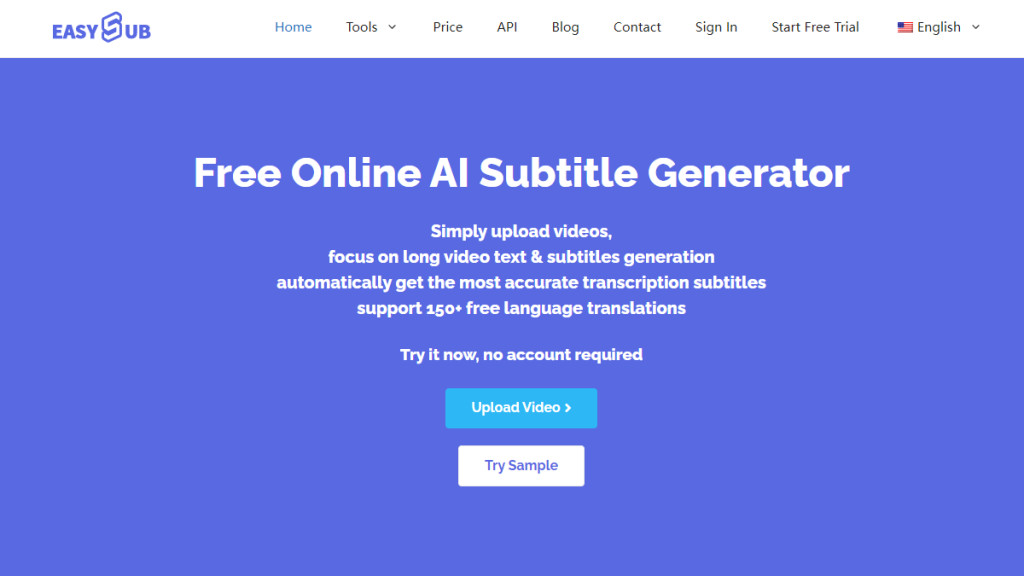
ਮੁੱਖ ਧਾਰਾ ਪਲੇਟਫਾਰਮਾਂ 'ਤੇ ਸੀਸੀ ਅਤੇ ਉਪਸਿਰਲੇਖ ਸਹਾਇਤਾ
ਵੱਖ-ਵੱਖ ਪਲੇਟਫਾਰਮਾਂ 'ਤੇ ਵੀਡੀਓ ਸਮੱਗਰੀ ਦੀ ਵਿਆਪਕ ਵੰਡ ਦੇ ਨਾਲ, ਹਰੇਕ ਪਲੇਟਫਾਰਮ ਦੀ ਉਪਸਿਰਲੇਖ ਫਾਰਮੈਟਾਂ (ਬੰਦ ਕੈਪਸ਼ਨਿੰਗ ਅਤੇ ਉਪਸਿਰਲੇਖ) ਦਾ ਸਮਰਥਨ ਕਰਨ ਦੀ ਯੋਗਤਾ ਨੂੰ ਸਮਝਣਾ ਵੀਡੀਓ ਸਿਰਜਣਹਾਰਾਂ ਅਤੇ ਸਮੱਗਰੀ ਪ੍ਰਬੰਧਕਾਂ ਲਈ ਬੁਨਿਆਦੀ ਗਿਆਨ ਵਿੱਚੋਂ ਇੱਕ ਬਣ ਗਿਆ ਹੈ।.
ਵੱਖ-ਵੱਖ ਪਲੇਟਫਾਰਮ ਉਪਸਿਰਲੇਖ ਅਪਲੋਡਿੰਗ, ਆਟੋਮੈਟਿਕ ਪਛਾਣ, ਫਾਰਮੈਟ ਅਨੁਕੂਲਤਾ ਅਤੇ ਭਾਸ਼ਾ ਸਹਾਇਤਾ ਦੇ ਮਾਮਲੇ ਵਿੱਚ ਵੱਖਰੇ ਹੁੰਦੇ ਹਨ। ਜਦੋਂ ਅੰਤਰਰਾਸ਼ਟਰੀ ਵੰਡ, ਇਸ਼ਤਿਹਾਰਬਾਜ਼ੀ ਪਾਲਣਾ, ਅਤੇ ਵਿਦਿਅਕ ਸਮੱਗਰੀ ਵੰਡ ਦੀ ਗੱਲ ਆਉਂਦੀ ਹੈ, ਤਾਂ ਜੇਕਰ ਉਪਸਿਰਲੇਖ ਫਾਰਮੈਟ ਪਲੇਟਫਾਰਮ ਦੀਆਂ ਜ਼ਰੂਰਤਾਂ ਨੂੰ ਪੂਰਾ ਨਹੀਂ ਕਰਦਾ ਹੈ, ਤਾਂ ਇਹ ਸਿੱਧੇ ਤੌਰ 'ਤੇ ਸਮੱਗਰੀ ਅਪਲੋਡਿੰਗ, ਦੇਖਣ ਦੇ ਅਨੁਭਵ ਦੀ ਕੁਸ਼ਲਤਾ ਨੂੰ ਪ੍ਰਭਾਵਤ ਕਰੇਗਾ, ਅਤੇ ਇੱਥੋਂ ਤੱਕ ਕਿ ਨੀਤੀ ਉਲੰਘਣਾਵਾਂ ਨੂੰ ਵੀ ਚਾਲੂ ਕਰੇਗਾ।.
| ਪਲੇਟਫਾਰਮ | ਸੀਸੀ ਸਹਾਇਤਾ | ਉਪਸਿਰਲੇਖ ਸਹਾਇਤਾ | ਸਵੈ-ਉਤਪੰਨ ਉਪਸਿਰਲੇਖ | ਬਹੁਭਾਸ਼ਾਈ ਸਹਾਇਤਾ | ਉਪਸਿਰਲੇਖ ਫਾਈਲਾਂ ਅੱਪਲੋਡ ਕਰੋ | ਈਜ਼ੀਸਬ ਤੋਂ ਸਭ ਤੋਂ ਵਧੀਆ ਫਾਰਮੈਟ |
|---|---|---|---|---|---|---|
| YouTube | ✅ ਹਾਂ | ✅ ਹਾਂ | ✅ ਹਾਂ | ✅ ਹਾਂ | ✅ .srt, .vtt | ✅ ਪੂਰੀ ਤਰ੍ਹਾਂ ਅਨੁਕੂਲ |
| ਵੀਮਿਓ | ✅ ਹਾਂ | ✅ ਹਾਂ | ❌ ਨਹੀਂ | ✅ ਹਾਂ | ✅ .vtt | ✅ ਵਰਤੋਂ .vtt ਫਾਰਮੈਟ |
| ਟਿਕਟੋਕ | ⚠️ ਸੀਮਤ | ✅ ਹਾਂ | ✅ ਸਧਾਰਨ ਆਟੋ-ਕੈਪਸ਼ਨ | ❌ ਕੋਈ ਬਹੁਭਾਸ਼ਾਈ ਨਹੀਂ | ❌ ਸਮਰਥਿਤ ਨਹੀਂ ਹੈ | ✅ ਓਪਨ ਕੈਪਸ਼ਨ ਦੀ ਵਰਤੋਂ ਕਰੋ |
| ਫੇਸਬੁੱਕ | ✅ ਹਾਂ | ✅ ਹਾਂ | ✅ ਮੁੱਢਲੀ ਆਟੋ-ਕੈਪਸ਼ਨਿੰਗ | ⚠️ ਸੀਮਤ | ✅ .srt | ✅ ਵਰਤੋਂ .srt ਫਾਰਮੈਟ |
| ਨੈੱਟਫਲਿਕਸ | ✅ ਲੋੜੀਂਦਾ | ✅ ਹਾਂ | ❌ ਨਹੀਂ | ✅ ਪੂਰਾ ਸਮਰਥਨ | ✅ ਡਿਲਿਵਰੀ-ਅਨੁਕੂਲ | ✅ ਪ੍ਰੋ ਐਕਸਪੋਰਟ ਦਾ ਸਮਰਥਨ ਕਰਦਾ ਹੈ |
| ਕੋਰਸੇਰਾ / ਈਡੀਐਕਸ | ✅ ਲੋੜੀਂਦਾ | ✅ ਹਾਂ | ❌ ਸਿਰਫ਼ ਹੱਥੀਂ | ✅ ਹਾਂ | ✅ .srt, .vtt | ✅ ਜ਼ੋਰਦਾਰ ਸਿਫ਼ਾਰਸ਼ ਕੀਤੀ ਜਾਂਦੀ ਹੈ |
- YouTube ਇਹ ਸਭ ਤੋਂ ਵੱਧ ਸਮਰਥਿਤ ਪਲੇਟਫਾਰਮ ਹੈ। ਬਹੁ-ਭਾਸ਼ਾਈ ਉਪਸਿਰਲੇਖ ਫੰਕਸ਼ਨ ਦੇ ਨਾਲ .srt ਜਾਂ .vtt ਦੀ ਵਰਤੋਂ ਕਰਨ ਦੀ ਸਿਫਾਰਸ਼ ਕੀਤੀ ਜਾਂਦੀ ਹੈ, Easysub ਨੂੰ ਪੂਰੀ ਤਰ੍ਹਾਂ ਅਨੁਕੂਲ ਬਣਾਇਆ ਜਾ ਸਕਦਾ ਹੈ।.
- ਵੀਮਿਓ ਵਪਾਰਕ ਜਾਂ B2B ਵਿਦਿਅਕ ਸਮੱਗਰੀ ਲਈ ਵਧੇਰੇ ਢੁਕਵਾਂ ਹੈ। Vimeo ਵਪਾਰਕ ਸਮੱਗਰੀ ਜਾਂ B2B ਵਿਦਿਅਕ ਸਮੱਗਰੀ ਲਈ ਵਧੇਰੇ ਢੁਕਵਾਂ ਹੈ। ਇਹ ਉਪਸਿਰਲੇਖਾਂ ਦਾ ਸਮਰਥਨ ਕਰਦਾ ਹੈ ਪਰ ਤਿਆਰ ਨਹੀਂ ਕਰਦਾ, ਇਸ ਲਈ ਉਪਭੋਗਤਾਵਾਂ ਨੂੰ ਅਪਲੋਡ ਕਰਨ ਤੋਂ ਪਹਿਲਾਂ ਉਹਨਾਂ ਨੂੰ ਬਣਾਉਣ ਲਈ Easysub ਦੀ ਵਰਤੋਂ ਕਰਨ ਦੀ ਸਿਫਾਰਸ਼ ਕੀਤੀ ਜਾਂਦੀ ਹੈ।.
- ਟਿਕਟੋਕ ਵਰਤਮਾਨ ਵਿੱਚ ਉਪਸਿਰਲੇਖ ਫਾਈਲਾਂ ਨੂੰ ਆਯਾਤ ਕਰਨ ਦਾ ਸਮਰਥਨ ਨਹੀਂ ਕਰਦਾ ਹੈ। ਅਸੀਂ ਏਮਬੈਡਡ ਓਪਨ ਕੈਪਸ਼ਨ ਵੀਡੀਓ ਬਣਾਉਣ ਲਈ Easysub ਦੀ ਵਰਤੋਂ ਕਰਨ ਦੀ ਸਿਫਾਰਸ਼ ਕਰਦੇ ਹਾਂ।.
- ਪਲੇਟਫਾਰਮ ਜਿਵੇਂ ਕਿ Coursera / edX / Netflix ਲਈ ਉੱਚ ਪੱਧਰੀ ਉਪਸਿਰਲੇਖ ਪਾਲਣਾ ਦੀ ਲੋੜ ਹੁੰਦੀ ਹੈ ਅਤੇ ਉਹਨਾਂ ਨੂੰ ਸਹੀ ਢੰਗ ਨਾਲ ਫਾਰਮੈਟ ਕੀਤੇ, ਸਪਸ਼ਟ ਤੌਰ 'ਤੇ ਸੰਰਚਿਤ CC ਅਤੇ ਉਪਸਿਰਲੇਖਾਂ ਦੀ ਵਰਤੋਂ ਕਰਨੀ ਚਾਹੀਦੀ ਹੈ, ਅਤੇ Easysub ਇਸ ਕਿਸਮ ਦੇ ਆਉਟਪੁੱਟ ਵਿੱਚ ਮਾਹਰ ਹੈ।.
- ਫੇਸਬੁੱਕ ਉਪਸਿਰਲੇਖਾਂ ਨੂੰ ਅਪਲੋਡ ਕਰਨਾ ਆਸਾਨ ਹੈ, ਸਿੱਧੇ ਆਯਾਤ ਲਈ .srt ਫਾਈਲਾਂ ਦੀ ਵਰਤੋਂ ਕਰਕੇ ਮਾਰਕੀਟਿੰਗ ਵੀਡੀਓਜ਼ ਲਈ ਢੁਕਵਾਂ ਹੈ।.
ਈਜ਼ੀਸਬ, ਵਨ-ਸਟਾਪ ਏਆਈ ਕੈਪਸ਼ਨਿੰਗ ਹੱਲ ਕਿਉਂ?
ਉਪਸਿਰਲੇਖਾਂ ਅਤੇ ਬੰਦ ਕੈਪਸ਼ਨਿੰਗ, ਐਪਲੀਕੇਸ਼ਨ ਦ੍ਰਿਸ਼ਾਂ ਅਤੇ ਪਲੇਟਫਾਰਮ ਸਹਾਇਤਾ ਵਿੱਚ ਅੰਤਰ ਨੂੰ ਸਮਝਣ ਤੋਂ ਬਾਅਦ। ਬਹੁਤ ਸਾਰੇ ਸਮੱਗਰੀ ਸਿਰਜਣਹਾਰ, ਵਿਦਿਅਕ ਸੰਸਥਾਵਾਂ ਅਤੇ ਉੱਦਮ ਉਪਭੋਗਤਾਵਾਂ ਨੂੰ ਇੱਕ ਵਿਹਾਰਕ ਸਵਾਲ ਦਾ ਸਾਹਮਣਾ ਕਰਨਾ ਪੈਂਦਾ ਹੈ: ਉਪਸਿਰਲੇਖਾਂ ਨੂੰ ਕੁਸ਼ਲਤਾ, ਸਹੀ ਅਤੇ ਲਾਗਤ-ਪ੍ਰਭਾਵਸ਼ਾਲੀ ਢੰਗ ਨਾਲ ਤਿਆਰ ਕਰਨ ਲਈ ਕਿਹੜੇ ਸਾਧਨਾਂ ਦੀ ਵਰਤੋਂ ਕੀਤੀ ਜਾ ਸਕਦੀ ਹੈ?
ਈਜ਼ੀਸਬ, ਇੱਕ ਦੇ ਤੌਰ ਤੇ ਆਟੋਮੈਟਿਕ ਸਬਟਾਈਟਲ ਜਨਰੇਸ਼ਨ ਟੂਲ ਪੇਸ਼ੇਵਰ ਏਆਈ ਤਕਨਾਲੋਜੀ ਦੁਆਰਾ ਸੰਚਾਲਿਤ, ਇਹਨਾਂ ਦਰਦ ਬਿੰਦੂਆਂ ਨੂੰ ਹੱਲ ਕਰਨ ਲਈ ਤਿਆਰ ਕੀਤਾ ਗਿਆ ਹੈ। ਹੋਰ ਉਪਸਿਰਲੇਖ ਸਾਧਨਾਂ ਦੇ ਮੁਕਾਬਲੇ, ਇਸ ਵਿੱਚ ਨਾ ਸਿਰਫ਼ ਬਹੁ-ਭਾਸ਼ਾਈ ਪਛਾਣ ਅਤੇ ਬਹੁ-ਫਾਰਮੈਟ ਆਉਟਪੁੱਟ ਵਰਗੀਆਂ ਨਿਯਮਤ ਵਿਸ਼ੇਸ਼ਤਾਵਾਂ ਹਨ, ਸਗੋਂ ਸ਼ੁੱਧਤਾ, ਗਤੀ, ਸੰਪਾਦਨਯੋਗਤਾ, ਅਨੁਵਾਦ ਸਮਰੱਥਾ, ਪਹੁੰਚਯੋਗਤਾ ਪਾਲਣਾ, ਆਦਿ ਦੇ ਮਾਮਲੇ ਵਿੱਚ ਵੀ ਮਹੱਤਵਪੂਰਨ ਫਾਇਦੇ ਹਨ।.
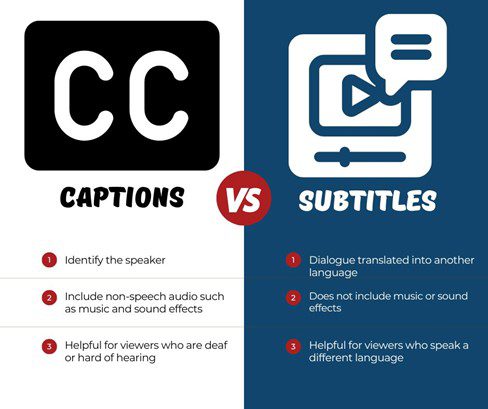
ਵੀਡੀਓ ਉਤਪਾਦਨ, ਸਮੱਗਰੀ ਨਿਰਯਾਤ, ਸਿੱਖਿਆ ਕੋਰਸ ਡਿਲੀਵਰੀ ਅਤੇ ਹੋਰ ਪ੍ਰੋਜੈਕਟਾਂ ਵਿੱਚ ਮੇਰੇ ਅਤੇ ਮੇਰੀ ਟੀਮ ਦੇ ਤਜ਼ਰਬੇ ਦੇ ਆਧਾਰ 'ਤੇ, Easysub ਦਾ ਪ੍ਰਦਰਸ਼ਨ ਦੂਜੇ ਟੂਲਸ ਨਾਲੋਂ ਕਿਤੇ ਬਿਹਤਰ ਹੈ। ਹੇਠ ਲਿਖੇ ਤਿੰਨ ਨੁਕਤੇ ਖਾਸ ਤੌਰ 'ਤੇ ਸ਼ਾਨਦਾਰ ਹਨ:
ਉੱਚ ਸ਼ੁੱਧਤਾ
ਯੂਟਿਊਬ ਆਟੋ-ਟਾਈਟਲਿੰਗ ਦੇ ਮੁਕਾਬਲੇ, ਈਜ਼ੀਸਬ ਦੀ ਮਾਨਤਾ ਦਰ ਕਾਫ਼ੀ ਜ਼ਿਆਦਾ ਹੈ। ਈਜ਼ੀਸਬ ਦਾ ਪ੍ਰਦਰਸ਼ਨ ਮਿਸ਼ਰਤ ਚੀਨੀ ਅਤੇ ਅੰਗਰੇਜ਼ੀ, ਉਪਭਾਸ਼ਾ ਉਚਾਰਨ ਅਤੇ ਤਕਨੀਕੀ ਸ਼ਬਦਾਂ ਵਰਗੇ ਗੁੰਝਲਦਾਰ ਸੰਦਰਭਾਂ ਵਿੱਚ ਸਥਿਰ ਹੈ।.
ਸੱਚਾ CC-ਅਨੁਕੂਲ ਉਪਸਿਰਲੇਖ
ਜ਼ਿਆਦਾਤਰ ਉਪਸਿਰਲੇਖ ਟੂਲ ਧੁਨੀ ਸੰਕੇਤਾਂ ਨਾਲ ਆਪਣੇ ਆਪ CC ਫਾਈਲਾਂ ਤਿਆਰ ਨਹੀਂ ਕਰ ਸਕਦੇ। Easysub ਪ੍ਰਕਿਰਿਆ ਕੁਸ਼ਲਤਾ ਨੂੰ ਕੁਰਬਾਨ ਕੀਤੇ ਬਿਨਾਂ ਇਹ ਕਰਦਾ ਹੈ।.
ਇੱਕ-ਸਟਾਪ-ਸ਼ਾਪ, ਤੁਹਾਡਾ ਬਹੁਤ ਸਾਰਾ ਸਮਾਂ ਬਚਾਉਂਦਾ ਹੈ
ਅਪਲੋਡ → ਪਛਾਣ → ਅਨੁਵਾਦ → ਸੰਪਾਦਨ → ਨਿਰਯਾਤ ਤੋਂ ਲੈ ਕੇ ਪੂਰਾ ਉਪਸਿਰਲੇਖ ਵਰਕਫਲੋ ਸਿਰਫ਼ ਕੁਝ ਮਿੰਟ ਲੈਂਦਾ ਹੈ, ਜਿਸ ਨਾਲ ਉਤਪਾਦਕਤਾ ਵਿੱਚ ਨਾਟਕੀ ਵਾਧਾ ਹੁੰਦਾ ਹੈ।.
ਆਪਣੇ ਵੀਡੀਓ ਨੂੰ ਪੇਸ਼ੇਵਰ ਅਤੇ ਵਿਸ਼ਵਵਿਆਪੀ ਪਹੁੰਚ ਦੇਣ ਲਈ ਸਹੀ ਉਪਸਿਰਲੇਖ ਚੁਣੋ।
ਇੱਕ ਪੇਸ਼ੇਵਰ ਦੀ ਚੋਣ ਕਰਨਾ ਉਪਸਿਰਲੇਖ ਜਨਰੇਟਰ, ਜਿਵੇ ਕੀ ਈਜ਼ੀਸਬ, ਤੁਹਾਨੂੰ ਤੁਹਾਡੇ ਉਪਸਿਰਲੇਖਾਂ ਦੀ ਗੁਣਵੱਤਾ ਅਤੇ ਉਤਪਾਦਕਤਾ ਵਿੱਚ ਨਾਟਕੀ ਢੰਗ ਨਾਲ ਸੁਧਾਰ ਕਰਦੇ ਹੋਏ ਸਮਾਂ ਅਤੇ ਲਾਗਤ ਬਚਾਉਣ ਦੀ ਆਗਿਆ ਦਿੰਦਾ ਹੈ। ਇਹ ਨਾ ਸਿਰਫ਼ ਬਹੁ-ਭਾਸ਼ਾਈ ਉਪਸਿਰਲੇਖ ਬਣਾਉਣ ਦਾ ਸਮਰਥਨ ਕਰਦਾ ਹੈ, ਸਗੋਂ ਪਹੁੰਚਯੋਗਤਾ ਜ਼ਰੂਰਤਾਂ ਨੂੰ ਵੀ ਪੂਰਾ ਕਰਦਾ ਹੈ, ਕਈ ਫਾਰਮੈਟਾਂ ਨੂੰ ਨਿਰਯਾਤ ਕਰਦਾ ਹੈ, ਅਤੇ ਸੰਪਾਦਨ ਅਤੇ ਵੰਡ ਦੀ ਸਹੂਲਤ ਦਿੰਦਾ ਹੈ, ਇਸਨੂੰ ਇੱਕ ਸੱਚਾ ਏਆਈ ਉਪਸਿਰਲੇਖ ਹੱਲ ਦੁਨੀਆ ਭਰ ਦੇ ਸਮੱਗਰੀ ਸਿਰਜਣਹਾਰਾਂ ਲਈ।.
ਇਸਨੂੰ ਮੁਫ਼ਤ ਵਿੱਚ ਅਜ਼ਮਾਓ easyssub.com ਵੱਲੋਂ ਹੋਰ - ਮਿੰਟਾਂ ਵਿੱਚ ਆਪਣੇ ਵੀਡੀਓਜ਼ ਲਈ ਉਪਸਿਰਲੇਖ ਤਿਆਰ ਕਰੋ। YouTube, TikTok, Vimeo, Coursera ਅਤੇ ਹੋਰ ਗਲੋਬਲ ਪਲੇਟਫਾਰਮਾਂ 'ਤੇ ਆਸਾਨੀ ਨਾਲ ਪ੍ਰਕਾਸ਼ਿਤ ਕਰੋ।.
ਅੱਜ ਹੀ ਆਪਣੇ ਵੀਡੀਓਜ਼ ਨੂੰ ਬਿਹਤਰ ਬਣਾਉਣ ਲਈ EasySub ਦੀ ਵਰਤੋਂ ਸ਼ੁਰੂ ਕਰੋ
ਸਮੱਗਰੀ ਵਿਸ਼ਵੀਕਰਨ ਅਤੇ ਛੋਟੇ-ਫਾਰਮ ਵੀਡੀਓ ਧਮਾਕੇ ਦੇ ਯੁੱਗ ਵਿੱਚ, ਆਟੋਮੇਟਿਡ ਉਪਸਿਰਲੇਖ ਵੀਡੀਓਜ਼ ਦੀ ਦਿੱਖ, ਪਹੁੰਚਯੋਗਤਾ ਅਤੇ ਪੇਸ਼ੇਵਰਤਾ ਨੂੰ ਵਧਾਉਣ ਲਈ ਇੱਕ ਮੁੱਖ ਸਾਧਨ ਬਣ ਗਿਆ ਹੈ।.
ਏਆਈ ਸਬਟਾਈਟਲ ਪੀੜ੍ਹੀ ਪਲੇਟਫਾਰਮਾਂ ਜਿਵੇਂ ਕਿ ਈਜ਼ੀਸਬ, ਸਮੱਗਰੀ ਸਿਰਜਣਹਾਰ ਅਤੇ ਕਾਰੋਬਾਰ ਘੱਟ ਸਮੇਂ ਵਿੱਚ ਉੱਚ-ਗੁਣਵੱਤਾ ਵਾਲੇ, ਬਹੁ-ਭਾਸ਼ਾਈ, ਸਹੀ ਢੰਗ ਨਾਲ ਸਮਕਾਲੀ ਵੀਡੀਓ ਉਪਸਿਰਲੇਖ ਤਿਆਰ ਕਰ ਸਕਦੇ ਹਨ, ਦੇਖਣ ਦੇ ਅਨੁਭਵ ਅਤੇ ਵੰਡ ਕੁਸ਼ਲਤਾ ਵਿੱਚ ਨਾਟਕੀ ਢੰਗ ਨਾਲ ਸੁਧਾਰ ਕਰ ਸਕਦੇ ਹਨ।.

ਸਮੱਗਰੀ ਵਿਸ਼ਵੀਕਰਨ ਅਤੇ ਛੋਟੇ-ਫਾਰਮ ਵੀਡੀਓ ਵਿਸਫੋਟ ਦੇ ਯੁੱਗ ਵਿੱਚ, ਆਟੋਮੇਟਿਡ ਸਬਟਾਈਟਲਿੰਗ ਵੀਡੀਓਜ਼ ਦੀ ਦਿੱਖ, ਪਹੁੰਚਯੋਗਤਾ ਅਤੇ ਪੇਸ਼ੇਵਰਤਾ ਨੂੰ ਵਧਾਉਣ ਲਈ ਇੱਕ ਮੁੱਖ ਸਾਧਨ ਬਣ ਗਿਆ ਹੈ। ਈਜ਼ੀਸਬ ਵਰਗੇ ਏਆਈ ਸਬਟਾਈਟਲ ਜਨਰੇਸ਼ਨ ਪਲੇਟਫਾਰਮਾਂ ਦੇ ਨਾਲ, ਸਮੱਗਰੀ ਸਿਰਜਣਹਾਰ ਅਤੇ ਕਾਰੋਬਾਰ ਘੱਟ ਸਮੇਂ ਵਿੱਚ ਉੱਚ-ਗੁਣਵੱਤਾ ਵਾਲੇ, ਬਹੁ-ਭਾਸ਼ਾਈ, ਸਹੀ ਢੰਗ ਨਾਲ ਸਮਕਾਲੀ ਵੀਡੀਓ ਉਪਸਿਰਲੇਖ ਤਿਆਰ ਕਰ ਸਕਦੇ ਹਨ, ਦੇਖਣ ਦੇ ਅਨੁਭਵ ਅਤੇ ਵੰਡ ਕੁਸ਼ਲਤਾ ਵਿੱਚ ਨਾਟਕੀ ਢੰਗ ਨਾਲ ਸੁਧਾਰ ਕਰਦੇ ਹਨ।.
ਭਾਵੇਂ ਤੁਸੀਂ ਇੱਕ ਸ਼ੁਰੂਆਤੀ ਹੋ ਜਾਂ ਇੱਕ ਤਜਰਬੇਕਾਰ ਸਿਰਜਣਹਾਰ, Easysub ਤੁਹਾਡੀ ਸਮੱਗਰੀ ਨੂੰ ਤੇਜ਼ ਅਤੇ ਸਸ਼ਕਤ ਬਣਾ ਸਕਦਾ ਹੈ। ਹੁਣੇ ਮੁਫ਼ਤ ਵਿੱਚ Easysub ਅਜ਼ਮਾਓ ਅਤੇ AI ਉਪਸਿਰਲੇਖ ਦੀ ਕੁਸ਼ਲਤਾ ਅਤੇ ਬੁੱਧੀ ਦਾ ਅਨੁਭਵ ਕਰੋ, ਜਿਸ ਨਾਲ ਹਰ ਵੀਡੀਓ ਭਾਸ਼ਾ ਦੀਆਂ ਸਰਹੱਦਾਂ ਤੋਂ ਪਾਰ ਵਿਸ਼ਵਵਿਆਪੀ ਦਰਸ਼ਕਾਂ ਤੱਕ ਪਹੁੰਚ ਸਕਦਾ ਹੈ!
ਕੁਝ ਹੀ ਮਿੰਟਾਂ ਵਿੱਚ AI ਨੂੰ ਤੁਹਾਡੀ ਸਮੱਗਰੀ ਨੂੰ ਸਸ਼ਕਤ ਬਣਾਉਣ ਦਿਓ!
👉 ਮੁਫ਼ਤ ਅਜ਼ਮਾਇਸ਼ ਲਈ ਇੱਥੇ ਕਲਿੱਕ ਕਰੋ: easyssub.com ਵੱਲੋਂ ਹੋਰ
ਇਸ ਬਲੌਗ ਨੂੰ ਪੜ੍ਹਨ ਲਈ ਧੰਨਵਾਦ।. ਹੋਰ ਸਵਾਲਾਂ ਜਾਂ ਅਨੁਕੂਲਤਾ ਲੋੜਾਂ ਲਈ ਸਾਡੇ ਨਾਲ ਸੰਪਰਕ ਕਰਨ ਲਈ ਬੇਝਿਜਕ ਮਹਿਸੂਸ ਕਰੋ!

